|
It took five years, over $5 million, and the expertise of hundreds of people,
but our country's oldest official documents—the Declaration of
Independence, the Constitution, and the Bill of Rights—are now safely
housed inside the most technologically advanced picture frames in the world.
Click on the cutaway illustration below to explore the components of the
Charters of Freedom encasements.—Lexi Krock
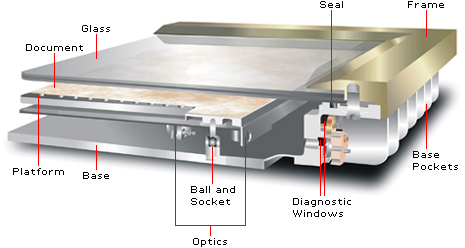
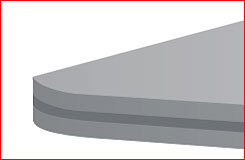
|
Glass
The 3/8-inch-thick glass window on the surface of each encasement has two jobs:
to protect the documents inside and to allow visitors the clearest possible
view of them. Each case's glass cover is a two-layer, heat-tempered sheet
capable of withstanding variations in barometric pressure and temperature, and
has a light-reflective coating that eliminates glare from the lighting in the
Rotunda of the National Archives, where the Charters are on permanent display.

|
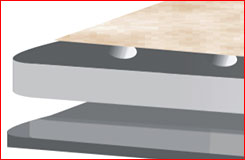
|
Platform
A lightweight aluminum platform supports a layer of celluloid paper and each
Charters document. The documents are all slightly different in size and none is
perfectly square, so each has its own specially machined aluminum platform. The
platform is perforated with about 4,000 holes, which provide moisture transfer
between the document and the environment inside the case. The documents are
held lightly onto the platform with small plastic clips that viewers can see
when looking into the encasements.

|
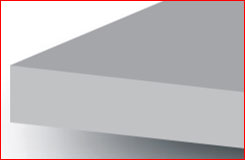
|
Base
The builders of the encasements crafted their bases by machining away most of
the material from which they're made, starting with blocks of aluminum about 40
inches square, three inches thick, and weighing more than 500 pounds each. The
end result looks like a large cake pan. The base's inside surface is anodized
in jet black, which gives viewers the impression that the Charters are floating
in midair.

|
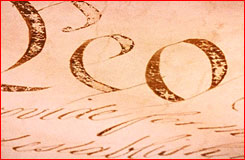
|
Document
Each of the Charters was handwritten with gall ink on parchment. They are
extremely fragile, even within their cases. The documents sit on single sheets
of archival paper made of pure cellulose. The paper absorbs and releases
moisture as necessary, and it creates an opaque background for the
semi-translucent documents, which are otherwise difficult to read. The
environment around the document is maintained at around 67°F with a
humidity level of about 45 percent to prevent the parchment from becoming
brittle. The case is filled with humidified argon, an inert gas that precludes
photo oxidation, the chief cause of fading.

|
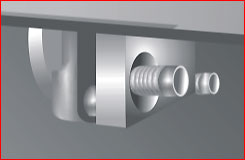
|
Optics
An intricate optical system sits beneath the platform on which the document
rests. Its purpose is to facilitate diagnostic tests of conditions inside the
encasements. When special light waves penetrate the case from one of two
diagnostic windows on its side, five mirrors reflect the beam and pass it out
of the second window, where a specially calibrated detector measures its
wavelength and intensity. These readings carry precise information about the
conditions inside the sealed case. Conservators usually monitor oxygen and
water levels, but they can use the optical system to run many other tests as
well.

|
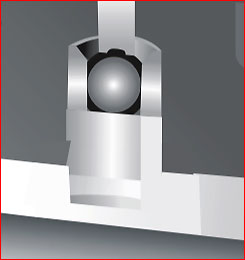
|
Ball and Socket
A ball-and-socket joint positioned between the platform where the document
rests and the bottom base of the encasement serves to locate and secure the
document platform in place. This joint ensures that the document is completely
immobile even during moving.

|
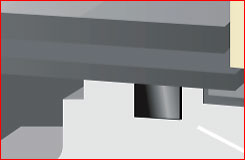
|
Seal
Experts developed a special vacuum seal between the encasement's base and front
glass to ensure a nearly impervious enclosure for the Charters. The seal is
made of a C-shaped piece of nickel and tin that deforms as the glass is pulled
tightly against the encasement's base, creating a leak-proof barrier.
Conservators' specifications for the ideal environment inside the closed cases
called for no more than 0.5 percent oxygen content—even after 100
years. Laboratory tests indicated that the seal will outperform these specifications.

|
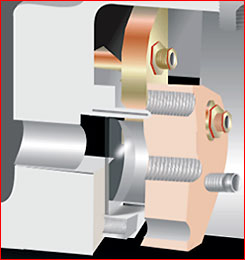
|
Diagnostic windows
Two small windows made of synthetic sapphire are set into the wall of the case's
base. They allow an absorption spectrometer's signal—a beam of light from
a cathode lamp—to pass into and out of the encasement beneath the
document. Readings from the signal help conservators evaluate whether the
humidity and gas content inside is stable. Scientists at the National Institute
of Standards and Technology chose synthetic sapphire for the windows' material
because it does not filter the infrared wavelengths needed to conduct sensitive
readings of the case's interior.

|
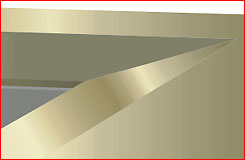
|
Frame
The titanium picture frame that surrounds each of the seven encasements on
display in the Rotunda of Washington's National Archives is plated with a thin
layer of gold. The frame was designed to be as light as possible yet provide
the strength necessary to hold the glass in place on the base and form an
airtight seal. The frame also provides an aesthetic complement to the grand
décor of the Rotunda, an important component of the Charters
re-encasement project.

|
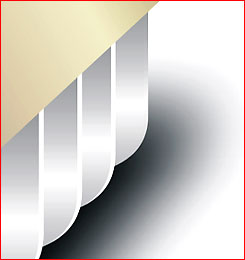
|
Pockets
To reduce the weight of the encasements and allow for easier moving when
necessary, waffle-like spaces were machined out of the metal wherever possible,
including on the bottom of the base, seen here, and concealed from view between
the bolts beneath the case's outer frame.

|
| 
|


